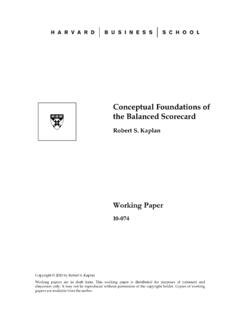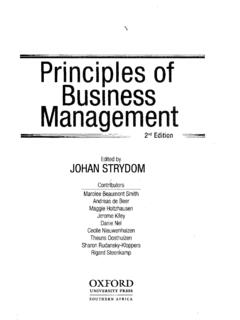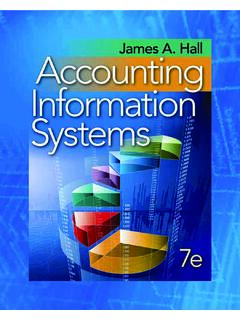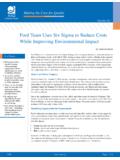Transcription of How the balanced scorecard complements the McKinsey 7-S …
1 How the balanced scorecard complementsthe McKinsey 7-S modelRobert S. KaplanIn Search of Excellence, the 1982 best-selling book by McKinsey partners TomPeters and Robert Waterman, introduced the mass business audience to the firm s7-S model. The model, also influenced by an earlier collaboration betweenMcKinsey and management scholars Richard Pascale and Anthony Athos (The Art ofJapanese Management, 1980), describes the seven factors critical for effective strategyexecution[1] The positioning and actions taken by an enterprise, in response to oranticipation of changes in the external environment, intended to achieve The way in which tasks and people are specialized and divided, and authorityis distributed; how activities and reporting relationships are grouped; the mechanisms bywhich activities in the organization are The formal and informal procedures used to manage the organization, includingmanagement control systems, performance measurement and reward systems,planning, budgeting and resource allocation systems, and management The people, their backgrounds and competencies; how the organization recruits,selects, trains, socializes, manages the careers, and promotes The distinctive competencies of the organization; what it does best alongdimensions such as people, management practices, processes, systems, technology,and customer The leadership style of managers how they spend their time, what theyfocus attention on, what questions they ask of employees, how they make decisions.
2 Alsothe organizational culture ( the dominant values and beliefs, the norms, the conscious andunconscious symbolic acts taken by leaders (job titles, dress codes, executive diningrooms, corporate jets, informal meetings with employees). values. The core or fundamental set of values that are widely shared in theorganization and serve as guiding principles of what is important; vision, mission, andvalues statements that provide a broad sense of purpose for all a search for the perfect organizational structure, the authors, and others,concluded that structure alone could not solve the problem of how to coordinate resourceallocation, incentives, and actions across large organizations. The 7-S model posits thatorganizations are successful when they achieve an integrated harmony among three hard S s of strategy, structure, and systems, and four soft S s of skills, staff, style,and super-ordinate goals (now referred to as shared values).)
3 While not all the companiesPeters and Waterman praised for excellence sustained their leadership performanceDOI 33 NO. 3 2005, pp. 41-46,QEmerald Group Publishing Limited, ISSN 1087-8572jSTRATEGY & LEADERSHIPjPAGE 41 Robert S. Kaplan is the MarvinBower Professor of LeadershipDevelopment at HarvardBusiness His recentbook, co-authored withDavid P. Norton,Strategy Maps:Converting Intangible Assets inTangible Outcomes(HarvardBusiness School Press, 2004) isa sequel to their classicTheBalanced scorecard :Translating Strategy into Action(HBSP, 1996).during the 1980s and 1990s, the 7-S model continues to be used in practice and inbusiness school teaching as a diagnostic and prescriptive framework for the academic literature, economists and strategy scholars tend to focus on the moretangible and measurable hard S s of strategy, structure and systems through studies of theimpact of mergers, alternative organizational forms, and incentive and reward in other social sciences (organization behavior, psychology, sociology, andanthropology) focus on the more intangible and difficult-to-measure softer S s of skills,staff, style, and shared years after Peters and Waterman introduced the 7-S model, Dave Norton and Ipresented the balanced scorecard (BSC) (see The balanced scorecard .)
4 Measures thatdrive performance, Harvard Business Review, January/February, 1992), a newmeasurement approach that organizes performance objectives and measures in fourperspectives:1. Thefinancial perspectivedescribes the tangible outcomes of the strategy in traditionalfinancial terms, such as return on investment (ROI), shareholder value, profitability,revenue growth, and lower unit Thecustomer perspectivedefines the drivers of revenue growth. It includes genericcustomer outcomes, such as satisfaction, acquisition, retention, and growth, as well asthe differentiating value proposition the organization intends to offer to generate sales andloyalty from targeted Theinternal process perspectiveidentifies the operating, customer management,innovation, and regulatory and social process objectives for creating and delivering thecustomer value proposition and improving the quality and productivity of Thelearning and growth perspectiveidentifies the intangible assets that are mostimportant to the strategy.
5 The objectives in this perspective identify which jobs (thehuman capital), which systems (the information capital), and what kind of climate (theorganization capital) are required to support the value creating internal use the scorecard to describe and communicate their strategy, to alignbusiness units and shared services to create synergies, to set priorities for strategicinitiatives, and to report on and guide the implementation of the more than a decade now, diverse organizations around the world ( manufacturing andservice, private sector and public sector, for profit and not-for-profit have used that BSC toachieve performance breakthroughs through focused and effective strategy execution. Weestablished the balanced scorecard Hall of Fame ( ) to recognizeand publicize the organizations that have been most effective in implementing the conceptand realizing benefits from we studied the two models, we came to realize that the 7-S model and the BSC strategicalignment models share many features in common.)
6 They both articulate that effectivestrategy implementation requires a multi-dimensional approach. They both stressinterconnectedness. For example, the diagram for the 7-S model looks like a spider-web,with each of the S s connecting with all the other six; the BSC strategy map (see Figure 1)illustrates cause-and-effect linkages across its four perspectives. Both models helpmanagers align their organization for effective strategy execution (see Table I). I believe that the BSC is not only fully consistent with the7-S framework, but can also enhance it in use. PAGE 42jSTRATEGY & LEADERSHIPjVOL. 33 NO. 3 2005 Beyond these similarities, I believe that the BSC is not only fully consistent with the 7-Sframework, but can also enhance it in use. The BSC s most obvious benefit arises whenmanagers use it to design a customized reporting and performance management system,the S, that many organizations fail to align with their other six S s.
7 The BSC enablesmanagement reports to focus on measures specifically selected to represent theorganization s strategy. The BSC also influences other organizational systems whenmanagers use it to align their planning, budgeting, and resource allocation systems, andtheir incentive and reward systems to strategy (as described in Kaplan and Norton, Usingthe balanced scorecard as a strategic management system, Harvard Business Review,January/February, 1996).Often, senior executives pay insufficient attention to adapting and aligning their systemseven while they are introducing new strategies and structures. They continue to employtraditional budgets and financial systems that are ill suited for the new strategies andstructures[2]. Some successful organizations, such as the pharmaceutical and medicalappliance giant Johnson & Johnson, cleverly use their traditional financial planning,budgeting, and variance reporting systems in a highly interactive manner to foster alignmentto strategy and structure[3].
8 But most companies have learned that financial systems alonecannot describe, communicate, guide, or evaluate their strategies. The BSC, by expandingmeasurement systems to include the nonfinancial indicators of the organization s strategy,has given managers a new tool to design and customize their system the third S ( to structure, the second S, companies face a complex choice among organizing byfunction, product groups, technologies, channels, market segments, or regions, or someFigure 1 BSC strategy map VOL. 33 NO. 3 2005jSTRATEGY & LEADERSHIPjPAGE 43combination thereof, such as in a matrix or networked organization. But even the best choicecannot solve the complex trade-offs between specialized local expertise and cross-unitintegration and synergies. The BSC reduces the pressure on managers to find and install theperfect structure.)
9 Whatever structural choice they make, when managers apply theenterprise scorecard to functions and units, these units become better aligned with eachother and to the enterprise. The process starts by applying the BSC at a high level, andletting the strategic objectives and themes cascade down to lower levels, where they areinterpreted and customized to the specific situation faced by lower level organizational is the process by which decentralized units become aligned with each other and to thecorporate can also use the comprehensive performance measures on the unit s BSC toassign clear responsibility and accountability for local and global performance. By using theBSC as the primary organizational system, decentralized unit scorecards reflect both thespecific competencies and strategies of the unit for local success, and also how each unitlinks with other units and the enterprise as a whole for the enterprise strategy to be strategy, structure and systems are tightly integrated, the odds for successful strategyimplementation are raised substantially.
10 But the BSC need not be limited solely tocompleting the alignment of the three hard S s. It also contributes a great deal to the four softer S s. The BSC s learning and growth objective specifically links the staff, theemployees knowledge, capabilities and skills, to the strategy. The process to identifystrategic job families highlights those positions that have the highest impact on deliveringthe organization s distinctive value proposition[4]. Further, the strategic objectives for theseemployees in the learning and growth perspective set the agenda that ensure the staffdevelop the requisite knowledge, capabilities, and skills to perform the strategic processesat the targeted IComparing the 7-S model and BSC7-S modelBSCS trategyDescribes and measures the strategy, including balance between short-run costsavings and long-term revenue growth, the customer outcomes expected from asuccessful strategy, the customer value proposition at the heart of the strategy,and the critical internal processes that create and deliver the differentiatedcustomer value propositionStructureApplying BSCs to diverse, decentralized units allows alignment across theseunits and to the corporate value proposition that enables synergies to be created.









